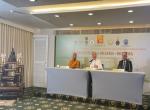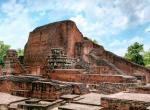Keynote Address delivered by
Professor B. B. Lal
(Former Director General, Archaeological Survey of India)
For quite some time a series of postulates have been distorting our vision of India's past. Some of these are:
1. The Vedas are no older than 1200 BCE and the Vedic people were nomads.
2. The authors of the Harappan Civilization, ascribable to the 3rd millennium BCE, were a Dravidian-speaking people.
This civilization was destroyed by Aryan invaders and thereby became extinct.
3. When it was demonstrated that there was no 'Aryan Invasion', another theory was floated, namely that the Aryans
were immigrants from the Bactria-Margiana Archaeological Complex of Central Asia.
Recent excavations at a number of sites in Rajasthan, Haryana, Panjab and Gujarat and a fresh study of the Vedic texts
have demonstrated that all the above postulates are ill-founded. We now know for certain that ---
1. The Rigveda is much older than 2000 BCE. A close scrutiny of the text clearly demonstrates that the Rigvedic people
were not nomads.
2. The Rigvedic domain and the area occupied by the Harappan Civilization were co-terminus and that the Vedas and
this civilization are but two faces of the same coin.
3. The Harappan Civilization did not become extinct. On the other hand, many of its features are noticeable even today.
4. The roots of the Harappan Civilization, on the basis of C-14 dating, go back to the 5th millennium BCE, if not earlier.
Thus, the Harappan/Vedic people were indigenous and not invaders or immigrants.
5. Further, archaeological and literary evidences combine to show that a section of the Vedic people emigrated to as far
west as Turkey, via Iran, some time at the beginning of the 2nd millennium BCE.
About Professor B.B. Lal
Born in 1921 and educated at the University of Allahabad and Institute of Archaeology, London, Professor B. B. Lal was
the Director General of the Archaeological Survey of India from 1968-72.
His excavations at sites associated with the Mahabharata and Ramayana have shown that there was a kernel of truth in
these epics, in spite of the fact that these have witnessed heavy interpolations. The excavation at Kalibagan has added
many new dimensions to our knowledge of the Harappan Civilization.
Professor Lal has published over hundred seminal papers in renowned research journals in India, USA, UK, Italy,
France, etc. and over a dozen books, the latest being How Deep are the Roots of Indian Civilization? Archaeology
Answers, on which is focused the current seminar.
Realizing the importance of Professor Lal's researches, the Institute of Archaeology, St. Petersberg, Russia, has
conferred on him an honorary D. Litt., while the President of India has honored him with Padma Bhushan.
Here with attach full abstract, full paper will made available soon.








Post new comment